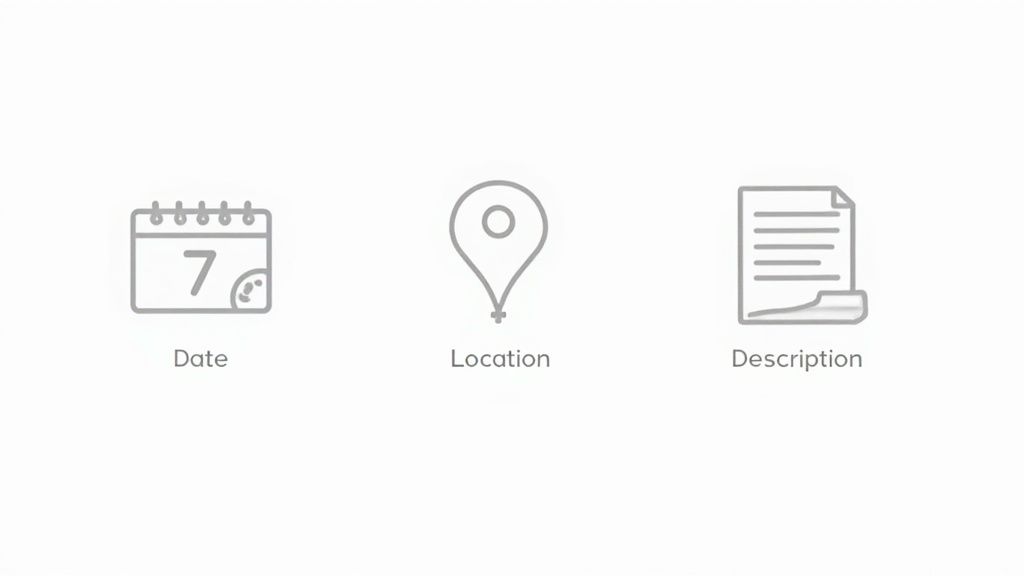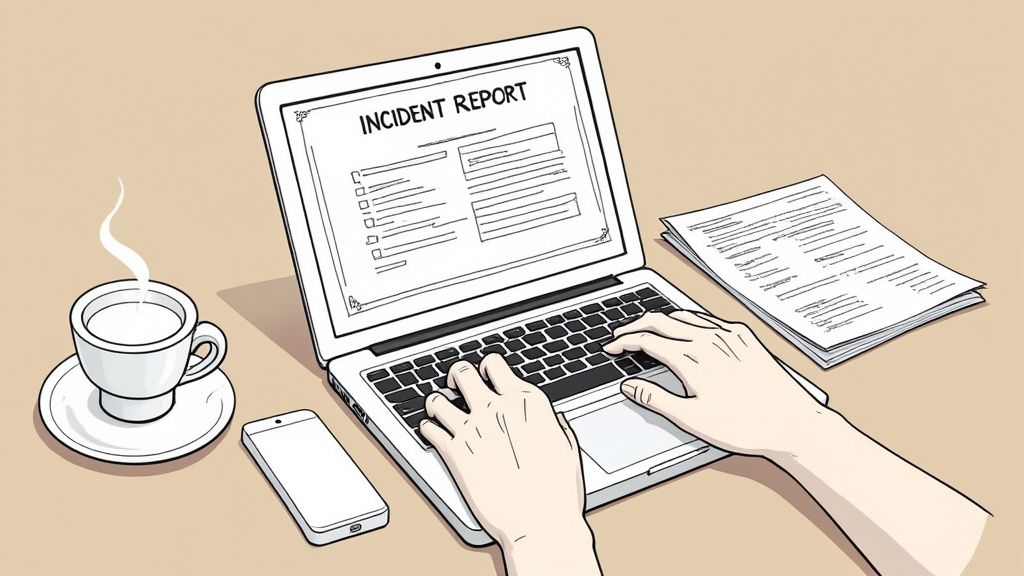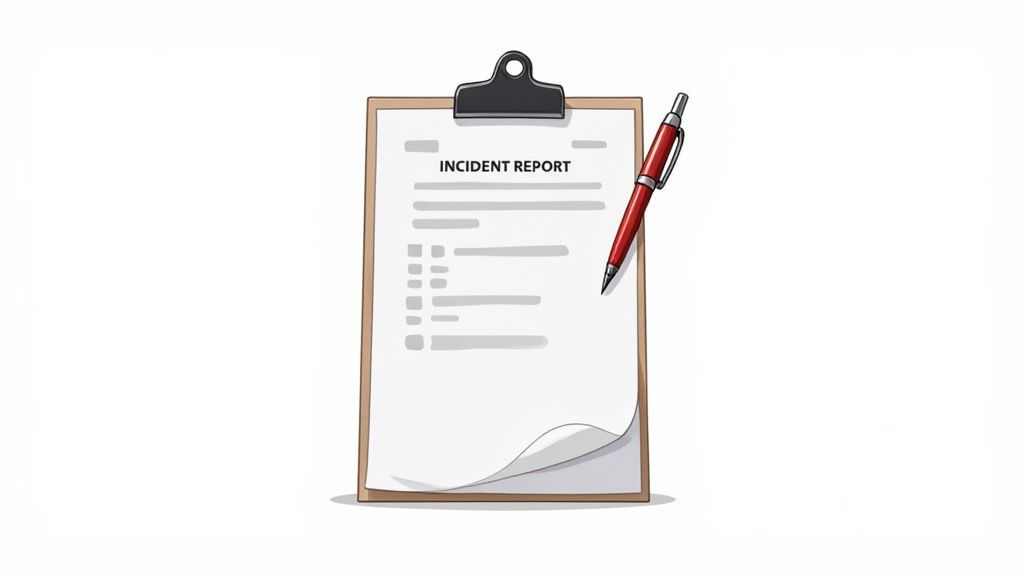An incident report is a formal document that captures all the details of a workplace accident, injury, or even a near-miss. Its main job is to create a clear and factual record of what happened, not to point fingers. This is especially important in places like construction or manufacturing, where understanding exactly what went wrong is the first step to making sure it never happens again.
What Is an Incident Report and Why Is It Important?
Think of an incident report as a practical tool for capturing the key facts around an event. It’s a snapshot of a specific moment, detailing who was involved, what occurred, and the where and when. This kind of documentation serves a few really important functions for any organization.
First, it provides a reliable account that you can use for official records and to meet compliance requirements. But more importantly, it helps you spot operational problems or hazards that might otherwise go unnoticed. A well-written report gives managers the solid information they need to dig in and find the root cause of an incident.
The Purpose of Detailed Reporting
A detailed report is much more than a box-ticking exercise for compliance. It becomes a foundational piece of data you can use to make real improvements in the workplace. For example, if you keep getting reports of slips in one particular area, it might point to a fluid leak from a machine that needs fixing. Without that paper trail, small problems can easily grow into bigger, more serious issues.
The whole point is to create a useful document that leads to real action. Any good incident reporting sample will always have sections that not only describe the event but also suggest practical, concrete steps to take next.
Checklist for a Complete Incident Report
To make sure nothing gets missed, a solid report should always cover a few key areas. We've put together a quick checklist to show you what a complete report looks like.
| Section | Purpose | Example Data Point |
|---|---|---|
| Basic Details | Establishes the core facts of when and where. | 14 June 2024, 10:15 AM, Assembly Line 3 |
| Persons Involved | Lists everyone directly part of the incident. | J. Smith (Operator), M. Chen (Witness) |
| Incident Description | Provides a factual, step-by-step account of events. | "Operator slipped on oil spill while walking." |
| Immediate Actions | Records the initial response to the incident. | "First aid was administered for minor scrapes." |
| Recommendations | Suggests practical steps to prevent a recurrence. | "Place absorbent mats around Machine B." |
Covering these five sections gives you a full overview that’s useful for immediate follow-up and long-term prevention.
Download Your Incident Reporting Sample Template

Before we dig in, I suggest grabbing our free incident report template. It’s been designed specifically for industrial environments like construction sites and factory floors, so it’s practical and straight to the point.
This guide is much more useful as a hands-on tool. Having the sample in front of you will make it easier to follow along with the step-by-step instructions in the next sections, turning advice into something you can actually use.
You can download the template in two handy formats:
- PDF Version: Perfect for printing off a few copies to fill out by hand on site.
- Word Version: An editable file you can tweak to better fit your own company’s processes.
If you’re looking for more ideas, you can also check out our other incident reports samples. They show a few different layouts and formats that might be a better fit for your organization.
How to Complete the Incident Report Step by Step

Alright, let's get practical. Filling out an incident report doesn't need to be complicated. The golden rule is to be factual, objective, and clear. Grab your downloaded incident reporting sample and let's walk through what actually goes into each section to create a document that’s genuinely useful.
The whole point is to paint a clear picture for someone who wasn't there. If your details are vague, the follow-up will be just as weak. So, let’s get specific.
Section 1: Basic Details
Think of this as the foundation. It's the who, what, where, and when that sets the scene for everything else. This data is also crucial for spotting trends down the line.
- Date and Time of Incident: Be precise. Don't just write "Tuesday morning." Put "14 August 2024, 10:25 AM." The more exact, the better.
- Location of Incident: Again, specifics matter. "Warehouse" isn't enough. It should be "Warehouse B, near loading bay 3."
- Persons Involved: Get the full name and job title of every person directly involved. This includes the person who was injured, the equipment operator, everyone.
- Witness Details: List the full names and contact details for anyone who saw what happened. Their perspective will be valuable for building a complete picture.
Section 2: Incident Description
This is where you stick to the facts. Just the facts. Your job here is to describe the sequence of events as it unfolded, without adding your own opinions or trying to figure out who's to blame. You're creating an objective record.
A clear, chronological account is the most valuable part of any report. Stick to what happened, not what you think happened. The difference is huge. For example, write "The worker slipped on a patch of oil," not "The worker was careless and slipped."
This level of detail is critical. Even large-scale organizations rely on it. The African Union, for instance, needs timely and accurate incident data from member states to manage public health threats effectively. You can see how they use this kind of information in the Africa CDC's weekly epidemic intelligence reports.
Your description should cover three key phases:
- Events Leading Up to the Incident: What was happening right before? (e.g., "Carrying a box of parts from the storage rack to Assembly Line 2.")
- The Incident Itself: A step-by-step rundown of the event. (e.g., "While turning the corner, their foot slipped on a wet patch on the concrete floor.")
- The Immediate Aftermath: What happened in the moments straight after? (e.g., "The box was dropped, and the worker fell, landing on their right side.")
Documenting Immediate Actions and Practical Recommendations
Once you've detailed what happened, the report needs to cover the immediate response. This part is a factual log of every single action taken in the moments after the incident. You’re creating a clear timeline so anyone reviewing the event later knows exactly what was done and when.
Get specific and just stick to the facts. Note down things like providing first aid, shutting down a piece of equipment, or securing the area to stop things from getting worse. For example, instead of a vague entry like "helped the injured person," a better record would be, "applied a pressure bandage to the cut on their left forearm and called the site first aid officer."
This simple flow chart gives you a bird's-eye view of the whole process.

It really shows how documenting the details is the critical link between spotting a problem and actually getting it reviewed for action.
Writing Useful Recommendations
Finally, a truly good report offers practical, sensible recommendations to stop the same thing from happening again. This is where your incident reporting sample goes from being a bit of paperwork to a genuine tool for improvement. Vague suggestions like "be more careful" are completely useless. What you need are concrete, actionable steps that can be ticked off a list.
Thinking about how to phrase your recommendations is key. The goal is to make them so clear that a manager can hand them off as a task without any confusion. Here’s what a good recommendation looks like compared to a weak one.
Effective vs Ineffective Recommendations
| Vague Recommendation | Specific & Actionable Alternative |
|---|---|
| "Improve lighting in the walkway." | "Install two additional LED light fixtures above the main walkway between Bay 3 and Bay 4 by 30 July." |
| "Workers should check equipment." | "Update the pre-start checklist for the CNC machine to include a daily check for hydraulic fluid leaks, effective immediately." |
| "Provide more training." | "Schedule a mandatory 30-minute toolbox talk on manual handling techniques for all warehouse staff by the end of the week." |
| "Be more aware of surroundings." | "Paint yellow hazard lines around the perimeter of the forklift operating zone to create a clear visual boundary for pedestrians." |
See the difference? Actionable recommendations make it incredibly easy for managers to assign tasks and, just as importantly, to confirm they’ve actually been done. It closes the loop and drives real change on site.
Common Mistakes to Avoid in Incident Reporting
Knowing what to do when writing an incident report is only half the battle. Just as important is knowing what not to do. A few common habits can trip people up, making a report less useful or, even worse, completely misleading.
If you can steer clear of these issues, you’ll ensure your report is a clear, factual tool that genuinely helps make the workplace safer for everyone.
Blame vs. Fact
One of the biggest mistakes I see is using blaming or emotional language. The whole point of an incident report is to understand what happened and why, not to point fingers at who was at fault. You have to stick to the objective, observable facts.
Let’s look at an example:
- Don't write: "The worker was careless and wasn't watching where he was going." (This is an assumption about their state of mind).
- Do write: "The worker was walking along the main path and slipped on an unmarked wet area." (This describes the facts and conditions).
That simple change shifts the focus from blaming an individual to identifying the hazardous conditions that led to the incident. That's where the real learning happens.

Unclear Details and Delays
Another classic error is delaying the report. It's human nature to put it off, but the longer you wait, the fuzzier the details become for everyone involved. Aim to get the report done as soon as it's safe and practical to do so, while memories are still fresh.
This doesn't just apply to injuries, either. It’s crucial for documenting near-miss events, too. Getting them on paper is vital for prevention.
Vague descriptions are just as unhelpful. They rob the report of its power. Be as specific as you possibly can.
Instead of writing "some boxes fell," a much better description is "Three cardboard boxes, each weighing approximately 15kg, fell from the top shelf of racking in Aisle 4."
Specific, timely data is everything. On a massive scale, the African Union gathered 48,294 detailed health incident reports between 2022 and 2025 using mobile tech to improve its safety surveillance. You can read more about how they analysed this extensive incident data, but the lesson is clear: high-quality information is the key to creating better outcomes.
Using Incident Data to Make Workplace Improvements
An incident report shouldn't just be a piece of paper you file away to tick a box. If that's all it is, you're missing the entire point. Think of it as the starting point for making real, practical improvements to how you work. The whole idea is to learn from what went wrong and make sure it doesn't happen again.
When you collect these reports over time, you're not just creating a paper trail; you're building a powerful dataset. A single incident might look like a one-off, a random bit of bad luck. But when you look at a dozen reports together, that's when the patterns start to jump out. You might suddenly realize there's a recurring problem with a specific machine on the factory floor, or a spike in trips and falls near a particular site entrance.
Turning Data into Action
A systematic review is what turns this raw data into clear direction. This isn't just a small-business idea; it's a principle recognized on a global scale. The African Union, for example, uses consistent incident data to improve risk reduction strategies across its member states. You can discover more about their data collection approach and see just how structured reporting can inform high-level policy. That exact same logic applies directly to your workplace.
So, how do you actually use the information from an incident reporting sample?
- Identify Trends: Look for the common threads. Are incidents happening at a particular time of day, in one specific department, or during a certain task? This is how you get past the symptoms and start digging into the root cause.
- Inform Decisions: This data is your evidence. It's one thing to have a gut feeling you need new equipment, but it's much more powerful to walk into a budget meeting with multiple reports showing it’s a genuine problem area.
- Track Progress: After you've put a fix in place, don't just assume it's worked. Keep an eye on new incident reports. Are the numbers going down? That's how you know your changes are actually making a difference.
A solid incident management system is what pulls all of this together, helping you organize and analyze the information without drowning in spreadsheets. It’s what moves your safety operations from being reactive to proactive, turning every single report into a tool that helps reduce risk across your business.
Common Questions About Incident Reporting
Got questions? We've got answers. This is where we tackle the most common queries about incident reports, giving you clear, practical advice to handle the process like a pro.
When Should an Incident Report Be Completed?
The simple answer? As soon as possible. Once any immediate danger is sorted and first aid has been given, that's the time to start the report.
Prompt reporting is important because memories fade fast. Details are freshest right after an event. Waiting even a day can cloud the specifics for everyone involved, making it much harder to piece together an accurate picture of what happened. For any significant incident, the goal should be to get the report submitted within 24 hours.
What Level of Detail Is Needed for a Minor Incident?
Even for something that seems minor, or even a near-miss, the rule is to be factual and specific. You still need to log the date, time, location, and a clear, objective description of what happened. Don't just write "almost slipped."
Instead, be precise: "Left foot slipped on a small, unmarked patch of oil near the hydraulic press." That level of detail gives someone who wasn't there enough information to understand the hazard and figure out how to fix it. A good report on a small issue today can prevent a major one tomorrow.
Who Is Responsible for Writing the Report?
Typically, this falls to the direct supervisor or manager of the area where the incident occurred. Their job is to gather the facts from the people involved and any witnesses to build an unbiased account.
In some organizations, the employee involved might fill out the first part of the form. However, the supervisor is almost always responsible for making sure the report is complete, accurate, and submitted correctly.
Ready to make your incident reporting straightforward and effective? Safety Space replaces messy paperwork with a simple, all-in-one platform. Spot problems early, keep your team safe, and stay compliant without the headache. Get your free demo and see how it works.
Ready to Transform Your Safety Management?
Discover how Safety Space can help you build a safer, more compliant workplace with our comprehensive safety management platform.
Book a Free DemoRelated Topics
Safety Space Features
Explore all the AI-powered features that make Safety Space the complete workplace safety solution.
Articles & Resources
Explore our complete collection of workplace safety articles, tools, and resources.
